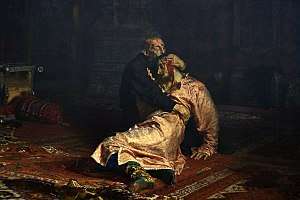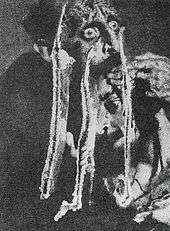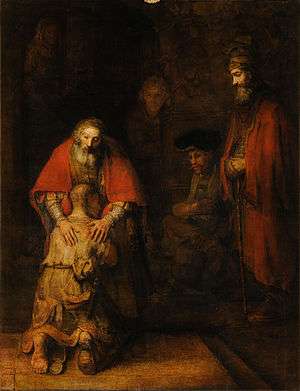Ivan the Terrible and His Son Ivan
| Ivan the Terrible and His Son Ivan on November 16, 1581 | |
|---|---|
|
Russian: Иван Грозный и сын его Иван 16 ноября 1581 года (Ivan Grozniy i syn ego Ivan 16 noyabra 1581 goda) | |
 | |
| Artist | Ilya Repin |
| Year | 1885 |
| Medium | Oil on canvas |
| Subject | Ivan the Terrible, Ivan Ivanovich |
| Dimensions | 199.5 cm × 254 cm (78.5 in × 100 in) |
| Location | Tretyakov Gallery, Moscow |
Ivan the Terrible and His Son Ivan on 16 November 1581 is a painting by Russian realist artist Ilya Repin made between 1883 and 1885. The picture portrays a grief-stricken Ivan the Terrible cradling his mortally wounded son, the Tsarevich Ivan Ivanovich. The elder Ivan himself is believed to have dealt the fatal blow to his son.[1]
The work is variously referred to as Ivan the Terrible and His Son Ivan, with or without the date, or Ivan the Terrible Killing His Son.[2][3] Repin's painting has been called one of Russia's most famous paintings, and is also one of its most controversial.[2][4][5] It has been vandalised twice, in 1913 and again in 2018.
The artist used Grigoriy Myasoyedov, his friend and fellow artist, as the model for Ivan the Terrible, with writer Vsevolod Garshin modelling for the Tsarevich.[3] In 1885, upon completion of the oil on canvas work, Repin sold it to Pavel Tretyakov, for display in his gallery.[2] It remains on display in the Tretyakov Gallery in Moscow.[6]
Background and content
In his memoirs, Repin said he was inspired to create the painting by the 1881 assassination of Tsar Alexander II, the music of Nikolai Rimsky-Korsakov, and the bullfighting he had witnessed in 1883.[2][3]
The work is a large canvas, 199.5 by 254 centimetres (78.5 in × 100.0 in).[7][8] The figures of Ivan and his son are depicted in a darkened room, with a blood red carpet.[9] Ivan wears an austere black coat, contrasting with the more extravagant pink satin dressing gown and teal green boots worn by his son. The room is furnished with 17th century furniture and objects, which themselves reflect the violence that has been done: a chair is overturned; the rug is bunched up by the Tsarevich's feet.[10]
Although one version of the title of the painting is Ivan the Terrible Killing His Son, the work does not depict Ivan the Terrible delivering a fatal blow, but rather the Tsar holding the Tsarevich in his arms, his face a mask of horror and despair, attempting to staunch the flow of blood from his son's temple. It probably dawns on the mentally unstable monarch that, by killing his son, he planted the seed for the Time of Troubles and the demise of his dynasty (as his only remaining heir is a dim-witted younger son who would be easily manipulated by powerful boyars).[11]
Differences between Repin's sketches and his final work indicate a distancing of the Tsar from the attack on the Tsarevich: in early versions, Ivan the Terrible is holding the sceptre used to deliver the blow, but the instrument is left out of the completed work.[7] The work is disturbing in the power of the emotions shown and in its "gory representation of violence".[12] Repin later said of the time when he painted it, that "A trail of blood ran through that year... Terrible scenes were in everybody's mind."[13]
The composition reflects two paintings by Rembrandt which Repin had studied and admired at the Hermitage, The Return of the Prodigal Son and David and Jonathan.[7]
Repin experimented with several different models for his subjects – for Ivan, an old man found by the painter Pavel Chistyakov, then a craftsman, the composer Pavel Blaramberg, and finally the painter Grigoriy Myasoyedov; for the Tsarevich, the landscape painter Vladimir Menk and finally the writer Vsevolod Garshin.[7]
Repin showed the completed painting to friends in 1885, to a mixed reaction, some praising its accomplishment, and others challenging its historical accuracy. Repin sold it to his patron Pavel Tretyakov.[2] He painted a second version of the painting in 1909 for Stepan Ryabushinsky, which was given the title Infanticide (Сыноубийца); it is held by the Voronezh Art Museum.[14]
 Small oil study for the painting, 22 x 36 cm (Tretyakov)
Small oil study for the painting, 22 x 36 cm (Tretyakov) Second version, painted in 1909. Also called Infanticide
Second version, painted in 1909. Also called Infanticide
Critical assessment
Repin's work has been compared to the Spanish school, and specifically to that of Jusepe de Ribera, for its "masterly regard for the dramatic effect" and its "primitive force and ferocity".[15]
Controversy
The events leading to the death of Tsarevich Ivan Ivanovich in November 1581 remain a controversial topic in Russia, with some Russian nationalists disputing the historical accuracy of the usual account of the event.[5]
Accounts vary on the causes of the death, the subject of any argument (if there was one) and the precise dates of the events. According to the usual account, relations between Ivan and his son were strained. The Tsar had his son's first two wives, Eudoxia Saburova and Feodosiya Solovaya, sent away to convents. While they were at the Alexandrov Kremlin in November 1581, Ivan is said to have assaulted his son's third wife, Yelena Sheremeteva, for being inappropriately dressed. She was pregnant, and the beating caused a miscarriage.[16] The Tsarevich reprimanded his father, and the Tsar responded by accusing his son of inciting rebellion by challenging his father and advocating attempts to relieve the on-going Siege of Pskov. Ivan struck his son with his sceptre, and also struck Boris Godunov when he tried to intervene. The Tsarevich fell to the floor bleeding heavily. Ivan was quickly remorseful, but his son died a few days later.[17]
Repin's piece was temporarily removed from public display at the Tretyakov Gallery when word spread that Tsar Alexander III found it offensive to represent the first Russian tsar (that is, the founder of the Tsardom of Russia) as a murderer.[2] The emperor himself forbade the exhibition of the painting until Alexey Bogolyubov petitioned him to change his mind.[18]
In 2013 an open letter was sent to the Russian culture ministry by Orthodox Christian activists. The letter alleged that the painting was offensive to Russians as it presented an untrue, distorted view of history.[2] The letter asked the Russian Minister of Culture Vladimir Medinsky to remove it from public display.[19] The director of the Tretyakov Gallery, Irina Lebedeva, objected.[2]
Vandalism
16 January 1913
The painting has been attacked twice. On 16 January 1913 (old style), Abram Balachov attacked the painting three times with a knife, making three parallel slashes over the faces of Ivan and his son. The director of the Tretyakov Gallery, Ilya Ostroukhov, resigned.[12] The curator of the Tretyakov Gallery, the landscape painter Georgy Khruslov was so distressed by the vandalism that he threw himself under a train. Repin returned to Moscow from Finland to restore the work.[6][12]
Repin viewed the attack as an expression of hatred towards his chosen artistic style and the older canons of taste with which he identified. He suspected that the attack was "the result of that monstrous conspiracy against the classic and academic monuments of art which is daily gathering momentum", i.e. modernism.[15]
Balachov's attack on the painting was applauded by Symbolist poet Maximilian Voloshin. Voloshin published an essay "On the significance of the catastrophe that befell Repin's painting" and publicly repeated his views in a lecture sponsored by futurists at the Moscow Polytechnic Museum. Repin himself was in the audience and came to the podium to respond.[12]
25 May 2018
The painting was attacked again on 25 May 2018 when an inebriated visitor to the gallery smashed the security glass around the painting because he believed it to be historically inaccurate. He used one of the metal security poles used to hold the rope to keep visitors at a distance.[6] The canvas was torn in three places though fortuitously not near the faces and hands of those portrayed.[4] Because the artist used a heavy canvas, the painting was better able to withstand the attack.[20] The damage was still reported as being "serious" with a special commission of art experts planning restoration which is expected to take several years.[2] Olga Temerina, the deputy head of the Grabar Art Conservation Centre, says that they have Repin's notes from the first attack which may help with restoration work.[2]
 Damage to the painting from the 1913 attack
Damage to the painting from the 1913 attack Damage to the painting from the 2018 attack
Damage to the painting from the 2018 attack
See also
References
- ↑ Perrie, Maureen; Pavlov, Andrei (2014). Ivan the Terrible. Routledge. p. 192. ISBN 978-1-317-89468-1.
- 1 2 3 4 5 6 7 8 9 10 Bodner, Matthew (27 May 2018). "Ivan the Terrible painting 'seriously damaged' in pole attack". The Guardian. Retrieved 30 May 2018.
- 1 2 3 "Ivan the Terrible killing his son". AllArt.biz. Retrieved 1 June 2018.
- 1 2 Kishkovsky, Sophia (28 May 2018). "Famous Russian painting of Ivan the Terrible vandalised in Moscow". The Art Newspaper. Retrieved 30 May 2018.
- 1 2 "Repin's "Ivan the Terrible:" Patterns in the theme of modernity". ArtGuide. 2013. Retrieved 31 July 2018.
- 1 2 3 "'Ivan the Terrible' Painting Damaged in Russia in Vodka-Fueled Attack". The New York Times. 27 May 2018. Retrieved 30 May 2018.
- 1 2 3 4 Valkenier, Elizabeth Kridl (January 1993). "The Writer as Artist's Model: Repin's Portrait of Garshin". Metropolitan Museum Journal. 28: 207–216. doi:10.2307/1512927. JSTOR 1512927.
- ↑ The Tretyakov Gallery, Moscow: Russian and Soviet Painting. Aurora Art Publishers. 1986.
- ↑ Fetzer, Leland (1975). "Art and Assassination: Garshin's 'Nadezhda Nikolaevna'". The Russian Review. 34 (1): 55–65. doi:10.2307/127759. JSTOR 127759.
- ↑ Haas, Barbara (2017). "Wrestling with Russia" (PDF). Still Point Arts Quarterly. Retrieved 31 July 2018.
- ↑ Н. А. Яковлева. Реализм в русской живописи: история жанровой системы. М.: Белый город, 2007. ISBN 9785779312080. P. 339.
- 1 2 3 4 Platt, Kevin M. F. (2007). "On blood, scandal, renunciation and Russian history, Il'ia Repin's Ivan the terrible and his son Ivan". In Levitt, Marcus C.; Novikov, Tatyana. Times of trouble : violence in Russian literature and culture. Madison, Wis.: University of Wisconsin Press. pp. 112–122. ISBN 9780299224301.
- ↑ Sternin, Grigori; Kirillina, Jelena (2013). Ilya Repin. New York: Parkstone Press International. p. 108. ISBN 9781844849161.
- ↑ ""A Day in the Museum for the Russian Cadets"". Voronezh Regional Art Museum. I.N. Kramskoy. Retrieved 31 July 2018.
- 1 2 Brinton, Christian (31 January 2003). The Ilya Repin Exhibition: Introduction and Catalogue of the Paintings. Held at the Kingore Galleries, New York City, 1921. Adamant Media Corporation. ISBN 9780543889850.
- ↑ Walthall, Anne (2008). Servants of the dynasty : palace women in world history ([Online-Ausg.]. ed.). Berkeley: University of California Press. ISBN 9780520254442.
- ↑ Madariaga, Isabel de (2006). Ivan the Terrible: first Tsar of Russia (2nd ed.). New Haven, Conn.: Yale University Press. pp. 340–342, 444. ISBN 9780300119732.
- ↑ "Иван Грозный и его сын Иван 16 ноября 1581 года" (in Russian). artchive.ru. Retrieved 1 June 2018.
- ↑ "Russia's Dangerous Struggle With Obscurantism". Radio Free Europe. 3 October 2013. Retrieved 30 July 2018.
- ↑ Lytvyn, Liliia. "Repin's masterpiece seriously damaged by vandal in Tretyakov Gallery". Art Hive. Retrieved 31 July 2018.

